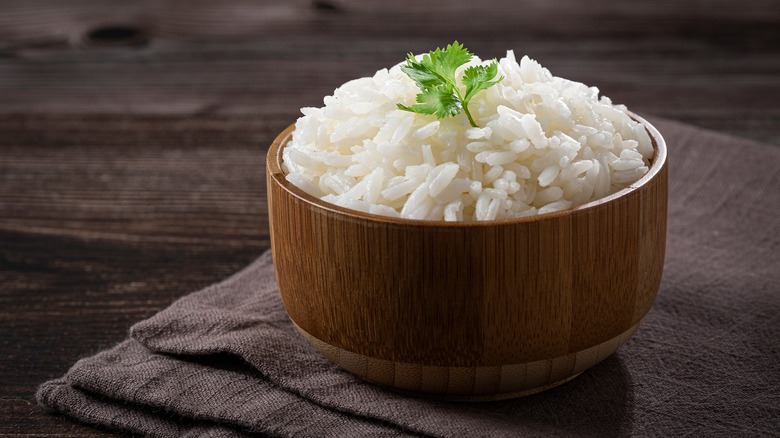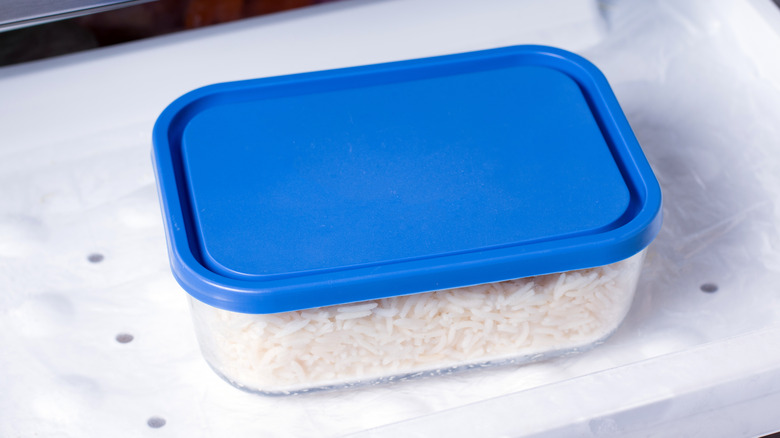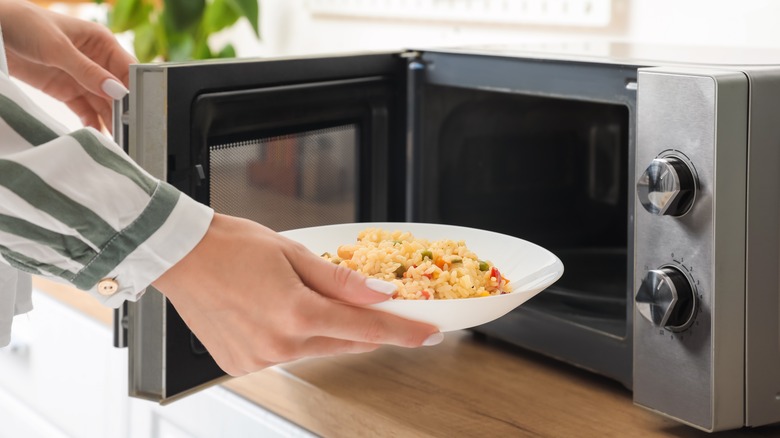How To Store Cooked Rice So It Doesn't Dry Out
Whether you're using an electronic rice cooker or the stovetop method, learning how to cook rice means it's always easy to whip up a filling and affordable meal using the pantry staple to soak up any delicious sauces. But if you've cooked too much, if you're planning to use it as part of meal prep for the days ahead, or even if you're just eyeing up that leftover takeout, you may be wondering how best to store it to avoid drying out. The key? Removing air.
Cooked rice can be stored in either the refrigerator or freezer, depending on how soon you'll use it. But the key is to prepare it for storage in the safest possible way to avoid spreading the Bacillus cereus (B. cereus) bacteria, which thrives in rice and can cause "fried rice syndrome," where incorrect storing and reheating can cause sickness. And that means that you need to act fairly quickly to cool the rice once it's been cooked, as its moisture content makes it an ideal environment for bacteria.
Rice needs to be chilled within two hours of cooking, so don't leave it out at room temperature for longer, as bacteria multiply in the "Danger Zone" between 40 and 140 degrees Fahrenheit, according to the Centers for Disease Control and Prevention. The quickest and most efficient way to cool rice once it's been cooked is to spread it out in a single layer on a baking sheet and then add it to your container.
Refrigerate or freeze cooked rice in an airtight environment
Once the rice has been cooled, it needs to be packaged correctly before being stored in the refrigerator or freezer. And that means letting as little air get to it as possible, so it doesn't become hard, dry, or chewy — so don't think you can just keep takeout rice in its cardboard box. For the fridge, place the leftover rice in an airtight container, or a zippable plastic bag, making sure you remove as much air as you can. Label it with the date; cooked rice will last around three to four days if stored correctly in the refrigerator (via USDA), and this applies to all different types of rice whether it's white, brown, wild, or another kind.
If you're looking to store some of the contents of an opened pre-cooked store-bought rice pouch for another meal, then the process is slightly different. The package can either be sealed, or you can transfer the contents to an airtight container before keeping it in the fridge. But either way, it should be consumed the same day or the next day to avoid the growth of bacteria.
If you want to store cooked rice for a longer period, then the freezer is the best bet. Just put the cooled rice into a labeled zippered freezer bag, squeezing out as much air as possible; lay food flat before freezing, which also saves space. It will keep for around three months.
How to reheat cooked rice so it's moist and fluffy
One of the problems with storing leftover rice in the refrigerator is it can go hard and clumpy. But it's possible to reheat it so it becomes moist and fluffy again, rather than dry and disappointing. Whichever method you choose for reheating, from the microwave to the stove, it's key to add a little water; around a tablespoon for each cup of rice is ideal.
The quickest way to reheat rice is the microwave. Using a microwavable container or plate, break down any clumps in the rice with a fork, and add the water. Cover it with a wet paper towel, and reheat it until it's fully heated through to at least 165 degrees Fahrenheit (via the USDA); that's around a minute per cup. Alternatively, you can reheat it until hot throughout in a skillet on the stove, adding water as well as a little butter or oil for extra moisture and flavor if you like.
To reheat frozen rice, break the solid block from the freezer bag into pieces in a bowl, cover it, and microwave it for around two to three minutes until it's fully heated. Just fluff it with a fork before serving to revive the original texture. Rice should only be reheated once to keep things safe, so if you're storing a large batch of cooked rice, it's best to portion it into individual servings first.



